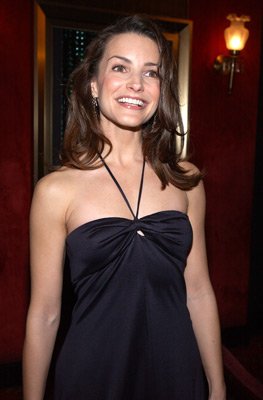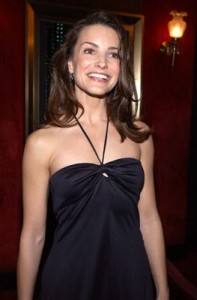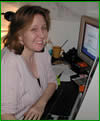
 Archival interview with Kristen Davis from the official Matrix website.
Archival interview with Kristen Davis from the official Matrix website.
MATRIX: How did you get into Computer Set Designing?
KRISTEN: Originally, I was an English major and I had always liked to draw. When I graduated I wanted to work in film, so I started working as a Production PA on commercials. Then I wanted to get skills that were more marketable and more in demand, so I started going to school at night, and I worked at a prop house. I’ve done pretty much every job in the Art Department: I’ve moved furniture, I’ve been a Set Dresser, I’ve been a Set Decorator, I’ve been an Art Director on smaller jobs; this is pretty much the best job I have ever had.
MATRIX: What are some of the other projects you have worked on?
KRISTEN: I’ve worked on all kinds of things. I worked on the Gus Van Sant version of Psycho, I’ve worked on TV shows: on the Donny and Marie show, I worked on a show called Rude Awakening on Showtime, and I’ve worked on a lot of different commercials. I’ve been doing this for fifteen years.
MATRIX: How did you come into this project, initially?
KRISTEN: I was teaching a class in Vector Works to other Set Designers and Art Directors, and I had pulled those really intricate Neb chairs off a web site, to show people what you can do working in 3D on the computer.
MATRIX: What web site did you pull them off of?
KRISTEN: It was a link to Diehl Graphsoft, the manufacturer of the program I use, and I was showing people what you can do in 3D. I guess they made eight of those chairs out of machined aluminum, and every part was modeled and all gorgeous. They used Vector Works and Form Z to create the chairs – they did all the nuts and bolts in Vector Works. I was showing this to the class, and one of the students, who happened to be working here, said she didn’t think I should be showing this, as everything is very hush, hush and very secret. I said it was on the web site, and it’s from the first film, but ask the Production Designer, and if he has any problem, I won’t show it. Owen [Paterson. Production Designer] said to her, “You’re taking a class in Vector Works? Have your teacher come in.” It was really exciting that I got that chance. I came in and had an interview with Owen, showed him my work, and started working here.
MATRIX: How does this project differ from some of the smaller ones you’ve worked on?
KRISTEN: What do people actually do? What is that you do? People ask me that, my family ask me that. On a big show, because there is so much to do, it divided up very finely. On a small show, you might have one person doing jobs that would take ten people to do on this show.
If you start at the top in the Art Department, the Production Designer is one of the three creative heads of the film, along with the Director of Photography, the Production Designer and, in this show, it seems like the Special Effects Designer. Those are the three creative heads. The Producer will hire these people or, in this case, the Producer and the Director are the same people – the brothers. Under them you have the Art Directors in the Art Department who supervise construction and everything the Art Department does on locations. Under the Art Director, you’ve got Set Designers, if the Art Director is implementing everything, the Set Designers are just drawing up sets. That’s what I do. This job has been unusual, in that I’ve done more conceptual work than I would on a normal film. So that’s a great break for me, because I get to get files directly from the Production Designer, and start to develop them, and do presentation drawings that have – not just construction drawings, which are about telling the construction foreman how to build the set with dimensions – but I’ve also been working with lighting, textures, perspectives and doing presentation drawings.
I have to step out of my box a little bit, so that’s really nice. The creativity on this project has been such that there is this wonderful flow of information, which you don’t get on a film that doesn’t have these kind of resources, or doesn’t have the people who understand the resources. So what the Directors are able to do is let everyone sort of percolate, do what they do, share information, and develop things in a really great way.
MATRIX: Do you find THE MATRIX 2 and 3 a large project?
KRISTEN: This is huge, it’s amazing; it’s two films, two huge films. When I was reading the script the first time I’d look at the page and go, “Oh my god, that’s going to be intense, that’s going to be awesome, it’s going to be huge!” I’d turn the page and there’d be another set, and turn the page and there’d be another set. Your mind just starts to reel, thinking, how are they going to do this? I’m involved right now in trying to define this because, again, lucky for me on this particular project, I have been involved in the seeds, the start of getting down on paper all of the major sets. On a lot of shows you don’t get to do that, you just get to work on your one or two little sets.
The technology Owen uses is a program called Vector Works, you can almost doodle in 3D in that program, because it is a simple program to use. It generates construction drawings and 3D models, so Owen has done a lot of starting models of sets, some of them are actually quite elaborate, and then he’s turned them over to me to develop, then they go to an illustrator, or they get developed in Maya [3D Animation and Visual Effects Software]. I have a list of what we’re trying to define, this is tedious, but a necessary breakdown of every single set. This list is eight pages long, and includes interior and exterior, every physical set there’s going to be. Trying to figure out what each set is going to be called is difficult. Who’s calling it what? There are hundreds of these sets of different sizes.
MATRIX: Do you think there are more decisions to be made on sets in this film, than in the typical film?
KRISTEN: Yes. Owen has got it all in his head, and the brothers have it all in their heads. That is also what is very cool about this is that the brothers have a fabulous visual ability, I guess it’s from comic books. They can translate narrative into a visual form, so they really know what they want, visually. At the same time, they understand the technology; so when they walk into the room to look at the pre-viz guys’ work, they are not looking at something foreign to them, they can look at it and get it. It’s very specific what your target is, a lot of shows are not like that, you’re just coming up with stuff, somebody looks at it, and they don’t get it, or it’s not what they wanted and they change it. Here, it’s all very specific, or else it would be impossible, you could never do anything this big. So they’re using the technology in a new way, and they’re using it really well. So there’s all these bits and pieces, now we’ve got to try and document what they’ve imagined, and they get a physical reality, that’s kind of scary.
MATRIX: How does Hugh Bateup, the Art Director, fit into the picture?
 KRISTEN: Hugh is the man that makes it happen. So Owen is dreaming all the things that are going to be, and then Hugh says how we’re going to do it. He’s putting together a whole squadron of people to make that happen in Australia, and that is going to be amazing, getting all those people up to speed on that. In a week or two, I may be going to Australia, which will be exciting.
KRISTEN: Hugh is the man that makes it happen. So Owen is dreaming all the things that are going to be, and then Hugh says how we’re going to do it. He’s putting together a whole squadron of people to make that happen in Australia, and that is going to be amazing, getting all those people up to speed on that. In a week or two, I may be going to Australia, which will be exciting.
MATRIX: Shooting is targeted for the fall [2001] in Australia, what will you be doing in Australia in a couple of weeks?
KRISTEN: Because I’ve been on this project since August [2000], and I know pretty much what Owen has in mind as basic concepts for a lot of the major sets, I’m in a position to go down there and say, “This is what Owen wants for this, now you guys can start running and developing these things.” We’ve already got some stuff ready for construction – documents and things like that. Every set is so vast you could sit there forever and go through the details, it takes forever to decide every little thing.
MATRIX: Is this all done on paper as blueprints?
KRISTEN: It can be printed out, but we’re going to do it on the computer mostly.
MATRIX: How detailed are the blueprints?
KRISTEN: Amazingly detailed, down to the nuts and bolts. Down to every hand rail, how wide every tread is, every step, how big the doors are, and how much molding there will be; every bit of that has to be decided.
MATRIX: Is it more of a challenge dealing with things and places that don’t exist, and have never existed, such as in the real world?
KRISTEN: When you think science fiction, there’s kind of a knee jerk reaction that it’s some weird abstract thing that’s never been seen. A lot of these sets are really spectacular, but a lot of it is very reality based. Whether it’s in the Matrix or elsewhere, there is a lot of reality to it, so it’s fantasy but it’s very concrete also. It’s taking ordinary things and making them extraordinary. I don’t think you could do what they’re trying to do without the computer.
MATRIX: A lot of the sets, in the real world particularly, are stressed, they look like they’ve been through hell, the metal itself has chunks taken out of it; do you have to plan for things to look like accidents?
KRISTEN: To a certain extent. There’s a certain organic randomness to the way things have grown up in this world over time. You have to be able to think that way, to think about the layers of things that have happened over time, and to build those layers in. That’s what Owen can see happening, so he’ll suggest to add layers of things in. At a certain point, as far as the dirt and the grunge and the damage go, a scenic [artist] will come in and muck up each set, putting in layers of dirt; so you need people who are artists at dirt.
MATRIX: What did you think of THE MATRIX film?
KRISTEN: The first film is fabulous. When you go to see it, it’s the sort of film that sticks in your head and changes the way you see things. It is exciting to work on something that people have actually connected with emotionally, that they’re excited about.
MATRIX: What makes this project special for you?
KRISTEN: This show is kind of like the epitome of everything I’ve ever wanted to do. Part of why this is such a great show is that Larry and Andy have such a distinct vision – you read about Hitchcock having storyboarded everything – they have that kind of an imagination. What Larry and Andy are doing, is pushing the technology; Owen is working with the CG people, and everyone is trying to do something that hasn’t been done before. That’s what’s exciting, every time technology shifts, the whole industry changes, and you can either be threatened by that, or you can rise to it. What happens is a lot of people are scared of it so they don’t get involved in it. When talkies came out they said it was the end of the industry, and for a lot of people it was the end of the industry. Silent films were beautiful, but they don’t make them anymore, something new came out of it; the same as when it switched from black and white to color, and when TV came out. This is a major, major shift, this is digital filmmaking, and it’s never going to be the same. The first MATRIX and these movies are going to be some of those movies that define what we do in the future.
The other aspect is, here we are struggling with this technology, we’re trying to do something that’s never been done before, and that’s what, thematically, the whole movie is about. So, here we are, just like Neo, stuck in our cubicle, trying to figure out what the hell is going on. We are inundated, and everything is hard and difficult and convoluted, and you feel like you’re trapped, but you also feel that you’re fighting the good fight. You’re trying to use this new technology because you can’t get rid of it, you can’t go back; we’re already out of Eden. We are trying to use it to serve us, and not us to serve it, so you really feel like you’re in THE MATRIX. That’s what Larry and Andy get, that we’re all in this world where we have to deal with this stuff, so it’s up to us to deal with it the right way. It’s like Neo’s choice, do you hide from it or do you fight it?
MATRIX: Thanks Kristen.
Interview by REDPILL
March 2001

Be the first to comment